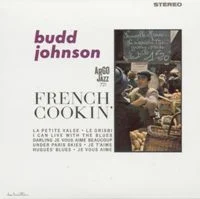Year: 2005
File: MP3@320K/s
Time: 35:09
Size: 81,2 MB
Art: Front
(3:03) 1. La Petite Valse
(5:41) 2. Le Grisbi
(4:30) 3. I Can Live With The Blues
(4:33) 4. Darling Je Vous Aime Beaucoup
(4:21) 5. Under Paris Skies
(3:47) 6. Hugues' Blues
(4:53) 7. Je Vous Aime
(4:19) 8. Je T'Aime
One of the earliest Texas tenors, arranging boss of the Earl Hines Grand Terrace Orchestra, and pivotal swing-to-bop figure, Budd Johnson distributed his gifts through several eras of jazz. He was a major composer and arranger and a saxophonist whose style fit as comfortably into bebop as it did into swing. Albert J. (Budd) Johnson was born in Dallas on December 14, 1910. His father was a choir director and cornetist who taught him piano at a young age. By Johnson's teenage years he had switched to drums and was playing with his brother, Keg Johnson, in bands around town. Eventually the two started their own group, the Moonlight Melody Six. They later joined Gene Coy's Amarillo-based band, the Happy Black Aces. Switching instruments again, this time to the saxophone, Johnson headed to Kansas City and then to Chicago, where he met and joined Louis Armstrong in 1933. During his stint in the Windy City he also met Earl Hines; their musical relationship lasted nine years. It was during his tenure with Hines that he came into his own as an arranger on top of being a solid member of the reed section.
By 1944 Johnson had moved to New York City, where he became involved in organizing and playing in smaller jazz combos, joining up with Coleman Hawkins, Dizzy Gillespie, Woody Herman, and Billy Eckstine, in whose band he replaced Dexter Gordon. Johnson became a pioneer of the emerging bop jazz style, and he is credited with organizing the first bop recording session. He remained an integral part of American jazz throughout the 1950s. In 1956-57 he played with Benny Goodman, with whom he toured Asia, and in 1958 he formed his own septet and recorded the album “Blues a la Mode.” In 1960 he did a stellar session “Budd Johnson and the Four Brass Giants,” for Riverside. Johnson, who takes tenor solos throughout the date and also contributes a bit of clarinet in addition to providing the arrangements, is matched with four distinctive and very different trumpeters: Clark Terry, Harry “Sweets” Edison, Nat Adderley and Ray Nance.
He seemed in top form that year (’60) for he also did “Let’s Swing,” which is regarded as one of his best efforts. He would go on to be involved in countless of sessions and too many recording to mention. During the 1960s Johnson played with Count Basie and Quincy Jones and rejoined Earl Hines in ’64. He formed the JPJ Quartet, which worked on an occasional basis, during the 1969-‘75 periods. He also served as music director for Atlantic Records and started his own publishing company. In the 1970s and 1980s he taught music at Queens College and the State University of New York at Stony Brook. Budd Johnson died in New York City on October 20, 1984. https://www.allaboutjazz.com/musicians/budd-johnson
Personnel: Budd Johnson – tenor saxophone; Hank Jones – piano; Kenny Burrell, Everett Barksdale – guitar; Milt Hinton – bass; Willie Rodriguez – latin percussion; Osie Johnson – drums; Joseph Venuto – marimba, vibraphone
By 1944 Johnson had moved to New York City, where he became involved in organizing and playing in smaller jazz combos, joining up with Coleman Hawkins, Dizzy Gillespie, Woody Herman, and Billy Eckstine, in whose band he replaced Dexter Gordon. Johnson became a pioneer of the emerging bop jazz style, and he is credited with organizing the first bop recording session. He remained an integral part of American jazz throughout the 1950s. In 1956-57 he played with Benny Goodman, with whom he toured Asia, and in 1958 he formed his own septet and recorded the album “Blues a la Mode.” In 1960 he did a stellar session “Budd Johnson and the Four Brass Giants,” for Riverside. Johnson, who takes tenor solos throughout the date and also contributes a bit of clarinet in addition to providing the arrangements, is matched with four distinctive and very different trumpeters: Clark Terry, Harry “Sweets” Edison, Nat Adderley and Ray Nance.
He seemed in top form that year (’60) for he also did “Let’s Swing,” which is regarded as one of his best efforts. He would go on to be involved in countless of sessions and too many recording to mention. During the 1960s Johnson played with Count Basie and Quincy Jones and rejoined Earl Hines in ’64. He formed the JPJ Quartet, which worked on an occasional basis, during the 1969-‘75 periods. He also served as music director for Atlantic Records and started his own publishing company. In the 1970s and 1980s he taught music at Queens College and the State University of New York at Stony Brook. Budd Johnson died in New York City on October 20, 1984. https://www.allaboutjazz.com/musicians/budd-johnson
Personnel: Budd Johnson – tenor saxophone; Hank Jones – piano; Kenny Burrell, Everett Barksdale – guitar; Milt Hinton – bass; Willie Rodriguez – latin percussion; Osie Johnson – drums; Joseph Venuto – marimba, vibraphone
French Cookin'


No comments:
Post a Comment
ALWAYS include your name/nick/aka/anything!